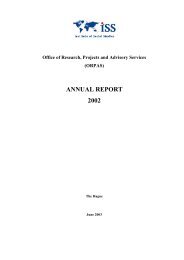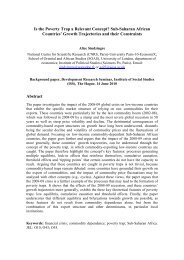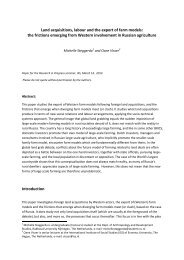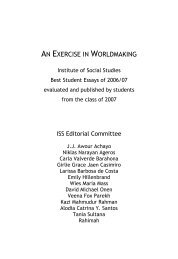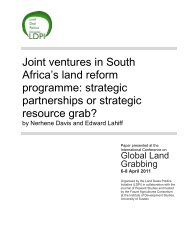AN EXERCISE IN WORLDMAKING 2009 - ISS
AN EXERCISE IN WORLDMAKING 2009 - ISS
AN EXERCISE IN WORLDMAKING 2009 - ISS
You also want an ePaper? Increase the reach of your titles
YUMPU automatically turns print PDFs into web optimized ePapers that Google loves.
7 Does the Aid Consensus Shift from Washington to the South? 81<br />
The growth diagnostic and investment climate analysis propose five sets of<br />
policy interventions for the Growth flagship:<br />
(i) develop skills and capacity for productive employment<br />
(ii) mprove the infrastructure especially energy, transport and communications<br />
(iii) promote science, technology and innovation, and<br />
(iv) strengthen the Financial Sector.<br />
(v) The final set of interventions, that is, improve governance to address<br />
the challenges associated with micro risks, pertains to the Governance<br />
Flagship. (ibid.: 50)<br />
Instead of “downsizing the state”, public spending thus plays an important<br />
role in these programmes. Public investment programmes are<br />
believed to spur private investments in the long run. They now focus on<br />
support for small businesses, for instance through Business Development<br />
Services and helping the private sector to innovate. There is a<br />
strong focus on reducing operational costs for business. Policies for improving<br />
technology and innovation come from the Ministry of Science,<br />
Technology and Scientific Research. When it comes to human resource<br />
development, attention is paid to improve secondary education and especially<br />
increase the number of graduates in science and technology, with<br />
the incentive of state funding for students . Productive employment relates<br />
to the long-term development goal of employing less people in the<br />
agricultural sector (GoR 2000).<br />
This can again be found in the second flagship in the EDPRSP, Vision<br />
2020 Umurenge, which is concerned with eradicating extreme poverty<br />
by 2020. As Stewart and Wang (2003) point out, Rwanda is one of<br />
the few countries that actually build a strong causal link between growth<br />
and poverty reduction. After diagnosis of the causes of poverty, Rwanda<br />
has built a program for poverty eradication based on empowerment<br />
through productive capacity, rather than redistribution or social protection.<br />
This is coherent with the Latent South Consensus (Gore op. cit.:<br />
789).<br />
The prioritisation of productive capacity can also be seen in the following<br />
remark on the current account deficit, representing a more<br />
Southern than neoliberal approach:<br />
The export base has traditionally been relatively narrow. Public investment<br />
will increase the imports of machinery and equipment by 15% per year on<br />
average and worsen the current account slightly. Over time, however the




